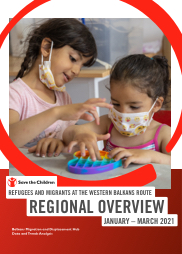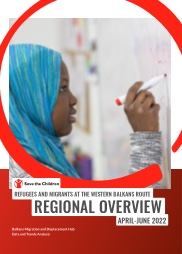
Study: Research
Balkans Migration and Displacement Hub Data and Trend Analysis: Regional Overview January-March 2021
Publication year:
2021
English
Format:
pdf (2.3 MiB)
Publisher:
Save the Children North West Balkans
Data and Trend Analysis (DATA) Refugees and Migrants at the Western Balkans Route Regional Overview January-March 2021 describes key trends in migrations in the region, detailing information about the number of people on the move, demography (age, sex, country of origin, etc), behavioral patterns, and routes in use – with a focus on children, particularly unaccompanied children.
Key trends showcased in this report:
- While migration between the countries in the Balkans continues, establishing the number of new arrivals and the number and structure of the refugee and migrant population present in the region remains a challenge due to the increasing gap in the quality and availability of the data on migration. This results in diminished visibility of the children and adults in need. It also leads to increased protection risks for the refugees and migrants, who are becoming one of the most vulnerable groups in the Balkans region and Europe.
- Eastern Mediterranean Route, taking refugees and migrants from Central, Western and Eastern Asia, and, in fewer numbers, those from African countries to Greece as an entry point to the Balkans Route, was the least frequented migration route to Europe in the first quarter of 2021. Decreased number of arrivals didn’t result in all children and adults in the Balkans having access to proper accommodation and services.
- While the number of arrivals in most of the Balkans’ countries decreased compared to the end of the last year, it still remained higher than in the first three months of 2020, demonstrating that the route might be “recovering” from the effects of the COVID-19 pandemics. At least 137,000 refugees and migrants were present in the countries along the route at the beginning of 2021, which is an increase compared to the same period of the last year, when around 128,000 people on the move were reported staying in various accommodation centres along the route.
- While Bosnia and Herzegovina Romania remained a key transit country, Romania continued facing an increased number of new refugee and migrant arrivals, with almost half of the last year’s asylum applications registered in the first three months of 2021.
Read full abstract
Authors
View & Download
Document information
Publisher
Authors
Format
Content type
Country
Region
Topics
Rights
© Author/Publisher
Found a mistake? Help us improve!
If you have noticed a document assigned to the wrong author or any other inaccuracies, let us know! Your feedback helps us keep our data accurate and useful for everyone.
Share
Link


